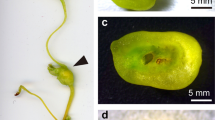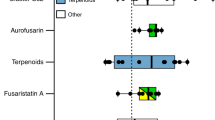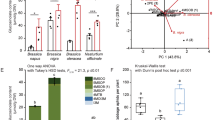Abstract
INSECTS feeding on toxic plants demonstrate three fairly distinct types of life-style1–3. There are cryptic species, which metabolise or rapidly excrete the toxic substances present or avoid their ingestion by selective feeding; aposematic or warningly coloured species which store plant toxins in their tissues unchanged or slightly modified4; and aposematic species which superficially resemble or mimic toxic species—without actually storing poisonous plant products—or those warningly-coloured non-storers which secrete their own toxins. It is generally agreed that the cryptic life-style is more ‘successful’ than either of the other two, which are relatively rare, and it is difficult to envisage the evolutionary steps necessary to enable a species to change to the more hazardous warning life-style. If, however, circumstances favour a switch to certain toxic host plants, a cryptic insect is frequently destined to become warningly coloured1,5. On the basis of experiments with Manduca sexta, the tobacco horn-worm, we suggest that the evolution of an aposematic poisonous insect, from the more common, harmless, cryptic type, may simply involve a change to a related food plant containing different toxic properties from those of its usual host. Storage and the acquisition of toxicity and warning colour could follow this crucial switch.
This is a preview of subscription content, access via your institution
Access options
Subscribe to this journal
Receive 51 print issues and online access
$199.00 per year
only $3.90 per issue
Buy this article
- Purchase on Springer Link
- Instant access to full article PDF
Prices may be subject to local taxes which are calculated during checkout
Similar content being viewed by others
References
Rothschild, M. in Insect Plant Relationships (ed. van Emden, H. F.) 59–83 (Blackwell, Oxford, 1972).
Rothschild, M. in Phytochemical Ecology (ed. Harborne, J. B.) 2–12 (Academic, New York & London, 1972).
Rothschild, M. & Reichstein, T. Nova Acta Leopoldina, Suppl. 7, 1–31 (1975).
Dixon, C. A., Erickson, J. M., Kellett, D. N. & Rothschild, M. J. Zool., Lond. 185, 437–467 (1978).
Rothschild, M. in Ecological Genetics and Evolution (ed. Creed, G. R.) 202–223 (Blackwell, Oxford, 1971).
Marsh, N. & Rothschild, M. J. Zool., Lond. 174, 89–122 (1974).
Hodgson, E., Self, L. S. & Guthrie, F. E. Proc. twelfth int. Cong. Ent. 210 (1975).
Yang, R. S. H. & Guthrie, F. E. Ann. ent. Soc. Am. 62, 141–146 (1969).
Yamamoto, R. T. J. econ. Ent. 62, 1427–1431 (1969).
Paik, N. H., Park, M. K. & Kim, M. S. Soul Taehakkyo Yakhak Nonmunjip 1, 26–39 (1976); (Chem. Abs., 87, 90771a, 1977).
Author information
Authors and Affiliations
Rights and permissions
About this article
Cite this article
ROTHSCHILD, M., APLIN, R., BAKER, J. et al. Toxicity induced in the tobacco horn-worm (Manduca sexta L.) (Sphingidae, Lepidoptera). Nature 280, 487–488 (1979). https://doi.org/10.1038/280487a0
Received:
Accepted:
Published:
Issue Date:
DOI: https://doi.org/10.1038/280487a0
This article is cited by
-
The invasive pest Drosophila suzukii uses trans-generational medication to resist parasitoid attack
Scientific Reports (2017)
-
Defensive Sound Production in the Tobacco Hornworm, Manduca sexta (Bombycoidea: Sphingidae)
Journal of Insect Behavior (2012)
-
10.1007/BF00221260
CrossRef Listing of Deleted DOIs (2011)
-
Host recognition by the tobacco hornworm is mediated by a host plant compound
Nature (2001)
-
Induced alkaloid defence inAtropa acuminata in response to mechanical and herbivore leaf damage
Chemoecology (1990)
Comments
By submitting a comment you agree to abide by our Terms and Community Guidelines. If you find something abusive or that does not comply with our terms or guidelines please flag it as inappropriate.



